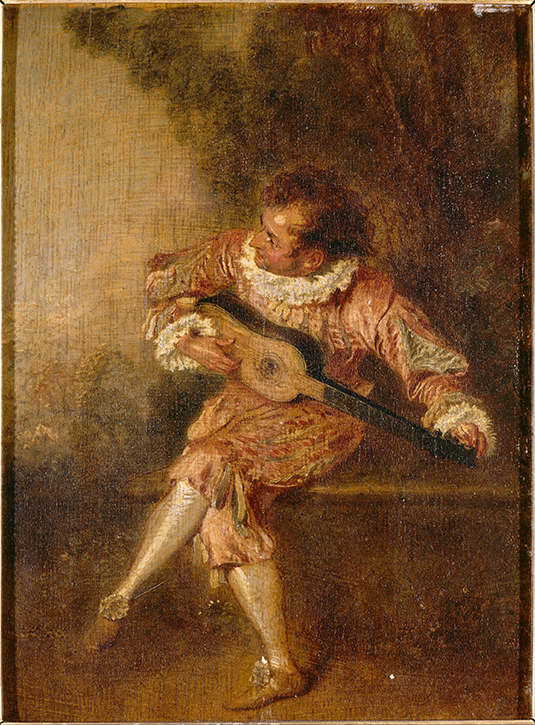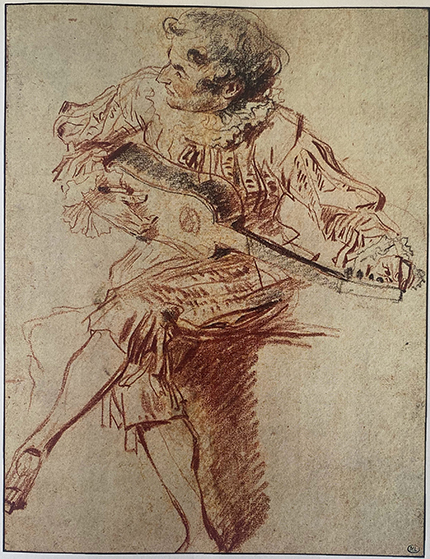
- Home Page
- Accepted
Paintings & Copies - Doubtful
Attributions - Doubtful Textual References
- Alternative
Titles - Collectors &
Museums - Bibliography
- Search Abecedario
- Watteau &
His Circle
Le Donneur de sérénade
Entered August 2020; revised May 2025

Chantilly, Musée Condé, inv. no. PE 371
Oil on panel
24 x 17 cm
ALTERNATIVE TITLES
Le Guitariste
Un Mezetin
L’Accord
Man Serenading
PROVENANCE
Paris, sale, collection of Marin Delahaye (1684-1753; Fermier géneral), January 1, 1754, lot. 47: “Un Tableau peint sur bois, représentant Mezetin par Vatteau, de 10 pouces de haut sur 7 pouces de large, dans sa bordure dorée.” Sold for 300 livres to Baucham [Beauchamp]. according to annotated copy of the sale catalogue in the Frick Art Reference Library, New York.
Sale, Paris, May 13, 1765, lot 58: “Un Tableau représentant un Mezetin, étude de Vateau, sur bois, de 8 pouces de haut, sur 7 pouces de large, dans sa bordure dorée.”
Paris, collection of Madame de Jullienne. Her sale, Paris, November 5, 1778, lot 40: ”un Mezzetin assis et pinçant de la guitare, peint au premier coup sur bois, par Watteau; 9 po. x 7 po.” Sold for 15 livres.
Paris, collection of Antoine Claude Chariot (1733-1815, commissaire-priseur du Châtelet). His sale, Paris, January 28, 1788, lot 44: “A. WATTEAU. . . . Le Donneur de sérénade, & l'Amante inquiette; deux études savants & remplies d’art, offrant deux Tableaux du meilleur tems de ce grand coloriste. Hauteur 9 pouces, largeur 7 pouces. B” Sold for 221 livres to Lebrun.
Paris, with Jean-Baptiste Pierre Lebrun (1748-1813; painter and art dealer). His sale, Paris, April 11, 1791, lot 210: “Deux Tableaux faisant pendans: l’un représente le donneur de sérénade; et l’autre l’amante inquiète; deux études savantes et remplies d’art: ils sont du meilleur temps de ce grand coloriste.—Hauteur, 9 pouces; largeur, 7 pouces. B. Ils viennent de la vente de M. Chariots, no 44: vendus 221 liv.* Ils sont gravés.” Sold for 132 livres to Lebrun.
Paris, with Alexandre Joseph Paillet (1743-1814; art dealer) or others. Sale, Paris, February 13ff, 1792, collection of lot 25: “PAR LE MÊME. [ANT. WATTEAU.] . . . Deux tableaux très fins de couleur & de la touche la plus spirituelle; l’un représente une jeune Bergère assise dans un paysage, & tenant des roses dans son tablier, l’autre un Homme vêtu à l’Espagnole, accordant une guitarre. Haut. 9 p. larg. 7. B.” Sold for 120 livres.
Paris, sale, March 20-22, 1824, lot 150: “”WATTEAU. Un joueur de guitarre et une esquisse, par le même.”
Collection of the marquis de Maison; sold in 1868 to Henri d’Orléans, duc d’Aumale.
Chantilly, collection of the duc d’Aumale (1822-1897); given with his collection to the Institut de France.
SELECT BIBLIOGRAPHY
Goncourt, Catalogue raisonné (1875), under cat. 81.
Gruyer, Chantilly (1898), 271.
Séailles, Watteau (1901), 75.
Watteau, Masters in Art (1903), 125.
Zimmermann, Watteau (1912), 176, pl. 28.
Dacier, Vuaflart, and Hérold, Jean de Jullienne et les graveurs (1921-29), 3: 43, 81, 100, under cat. 215.
Réau, “Watteau” (1928), cat. 94.
Adhémar, Watteau (1950), cat. 144.
Mathey, Watteau, peintures réapparues (1959), 68.
Vergnet-Ruiz and Laclotte, Great French Paintings (1965), 70.
Macchia and Montagni, L’opera completa di Watteau (1968), cat. 130.
Ferré, Watteau (1972), cat. A10.
Roland Michel, Watteau (1981), cat. 170.
Roland Michel, Watteau (1984), 230, 279.
Posner, Watteau (1984), 169.
Rosenberg and Prat, Watteau, Catalogue raisonné des dessins (1996), 459.
Temperini, Watteau (2002), cat. 58.
Glorieux, Watteau (2011), 217, 218.
Brussels, Palais des beaux-arts, Watteau, Leçon de musique (2013), under cat. 47.
Les Collections du musée Condé, http://www.musee-conde.fr, 2020.
RELATED DRAWINGS

Watteau, Study of a Seated Guitarist, red and black chalk, 26.4 x 20.3 cm. Paris, Musée du Louvre, Département des arts graphiques.
The guitarist in Le Donneur de sérénade is based directly on a red and black chalk drawing in the Louvre (Rosenberg and Prat 459), which is as spirited as the painting. Watteau used the same study in two other paintings, La Surprise and the more ambitious Réunion en plein air in Dresden.
REMARKS
The 1778 sale in which Le Donneur de sérénade appeared was described as containing works “provenans du Cabinet de feue Madame de Jullienne.” Some might wonder, then, if this painting had not previously been in the collection of Monsieur de Jullienne as well, but this is not the case. It is not listed in the c. 1765 manuscript inventory of his collection nor in the 1767 sale of his collection. Apparently Madame de Jullienne bought works on her own.
The painting was not engraved for the Jullienne Oeuvre gravé (probably because it would essentially have duplicated the print after the Mezzetin, now in the Metropolitan Museum, which also depicts a guitarist in theatrical costume serenading an unseen female. Nonetheless, even without the engraving, there has been no hesitation about its authorship. Indeed, the vibrant brushwork, matched by the guitarist’s charismatic personality, is brilliant. It is not by chance that the picture was described in the eighteenth century as “une étude savant,” or “peint au premier coup.” It is a tour-de-force of bravura painting although, ironically, it was preceded by a careful drawing from the model.
The painting has generally been dated by Watteau scholars to the middle years of the artist’s career. Mathey saw it as a work of c. 1714. Macchia and Montagni proposed that it was executed a year later, c. 1715; Roland Michel suggested c. 1715-16; Adhémar listed it at 1716; and Rosenberg and Prat dated the preliminary drawing to c. 1716. Temperini pushed the date of the painting slightly later, to 1716-17.
Ever since the second half of the eighteenth century, when Le Donneur de sérénade and L’Amante inquiète were in the Chariot collection, they have been understood as pendants. They are well balanced visually and psychologically: he aggressive and powerful, thrusting forward, she reticent and pulling back. Yet, despite their harmonious contrast, as these two works are, they were not planned as pendants by Watteau. At the outset, L’Amante inquiète had been by itself in the collection of the abbé Haranger, and Le Donneur de sérénade had been alone when it was in the possession of Delahaye and Lebrun. They did not emerge as pendants until they were both in the Chariot collection, and one wonders if Lebrun, cognizant of all the Watteau paintings on the market, did not have a hand in matching them up. Whoever was responsible, it was a clever move.
Click here for copies of Le Donneur de sérénade